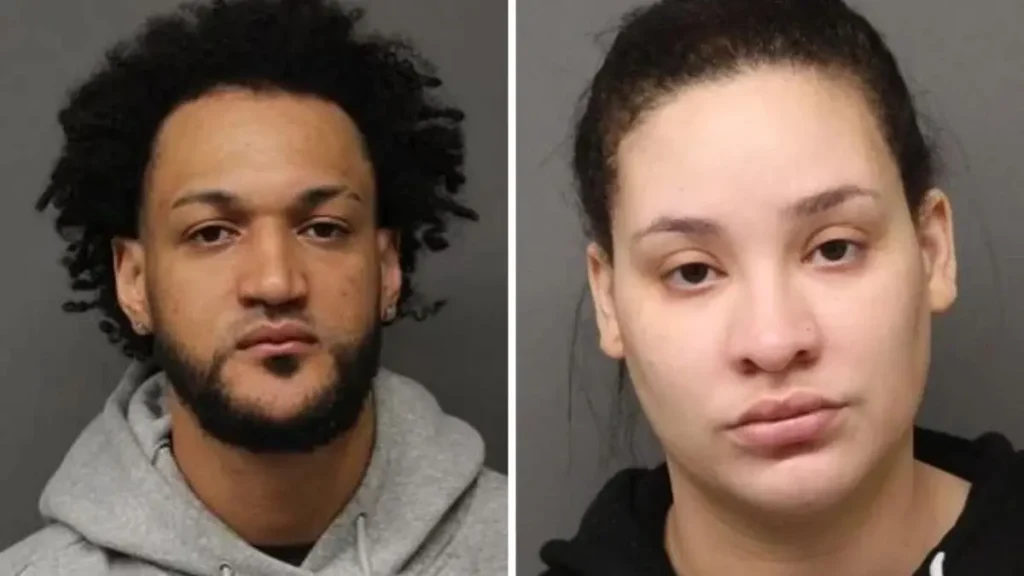N.J. Police Arrest Couple Accused of Staging Home Invasion to Cover Shooting
When I first read about this case, I had to double-check the headline. A supposed home invasion in Moonachie, New Jersey — the kind of early-morning panic no homeowner ever wants to experience — turned out to be something completely different.
Police say the 911 call came in just before sunrise on October 14. Officers rushed to a quiet neighborhood and found Juan B. Rodriguez-Santos, 30, bleeding from a gunshot wound to his leg. His partner, Lisa M. Palacio, 29, looked shaken as she told investigators someone had broken in and attacked him. For a few hours, it sounded like another terrifying burglary story — until the pieces stopped fitting together.
As the morning unfolded, detectives began to notice inconsistencies. Rodriguez-Santos first claimed he’d been stabbed, then changed it to a masked man with a gun. Palacio said she thought someone had entered the home, but later admitted she wasn’t sure what really happened.
The story started to wobble, and by the time Bergen County Prosecutor Mark Musella briefed the press, the truth had already started to crack through: there had been no home invasion at all.
It’s one of those moments that makes you pause — how does a report of a violent crime turn into a case of alleged deception? The answer, it turns out, would expose more than just a lie about a shooting.
So, what really happened inside that Moonachie home — and why would anyone fake something so serious?
“A Masked Intruder Did It” — The Story That Fell Apart

At first, the story sounded like something straight out of a crime show. According to Daily Voice, Rodriguez-Santos told police a masked man had burst into the home, tried to rob him, and shot him once in the leg. Palacio backed him up, saying she believed someone had broken in.
But as investigators started piecing together the timeline, cracks appeared almost immediately. No neighbors heard gunfire or saw anyone flee. There were no signs of forced entry — no broken locks, no footprints, nothing missing.
That’s when detectives began to realize something wasn’t right. Rodriguez-Santos had changed his story more than once, first saying he was stabbed before shifting to the gun narrative. Palacio’s own version kept evolving too.
From experience, I’ve seen how panic can twist a story — but this felt different. The inconsistencies weren’t just emotional confusion; they hinted at fabrication. What started as a call for help was quickly turning into a criminal investigation of its own.
What Investigators Really Found?
Detectives eventually confirmed what the evidence had been whispering all along: there was no home invasion. The gunshot wound in Rodriguez-Santos’s leg was self-inflicted, and Palacio had allegedly hidden the gun to cover it up.
It didn’t end there. Investigators also discovered that Rodriguez-Santos possessed personal identifying information belonging to other people — a clue that the staged attack might have been a distraction from something else entirely.
This reminded me of another New Jersey case, where a woman fabricated a home-invasion story to hide her own theft from a roommate. She, too, ended up charged once police dug past the surface. The pattern is eerily familiar: fear of exposure often triggers a bigger lie — one that unravels faster than anyone expects.
This isn’t the first time investigators have uncovered a twisted version of “the truth” in a home invasion report. In Oak Lawn, Illinois, police faced a similar situation when a supposed burglary spiraled into armed robbery charges. The pattern feels all too familiar — panic, deception, and the cost of getting caught in your own story.
The Charges and Legal Stakes
By the end of the week, the couple faced a long list of charges.
Rodriguez-Santos was charged with:
- Second-degree making false reports to law enforcement
- Third-degree hindering apprehension (two counts)
- Fourth-degree trafficking in personal identifying information
- Fourth-degree tampering with physical evidence
Palacio faced similar counts:
- Second-degree making false reports
- Third-degree hindering apprehension (two counts)
- Fourth-degree tampering with evidence
Both were taken to the Bergen County Jail, appeared in Superior Court in Hackensack, and were later released pending further hearings.
Now, if you know New Jersey’s criminal statutes, you understand how serious this is — a second-degree charge can mean up to 10 years in prison. What started as an early-morning emergency call had officially become a case of faking a felony.
Why People Fake Crimes — What Experts Say

I’ve covered crime for years, and this part never gets less strange — the “why.” Why would someone risk years behind bars to fake a story like this?
Criminal psychologists often point to three motives:
- Fear — of getting caught in another mistake (like mishandling a firearm).
- Control — trying to shape the narrative before someone else does.
- Avoidance — sidestepping embarrassment, insurance issues, or legal fallout.
Dr. Stanton Samenow, a well-known forensic psychologist, once wrote that offenders who fabricate crimes often “use deceit as a coping mechanism to manage guilt and regain power over their circumstances.” That quote fits here almost perfectly.
When you think about it, this isn’t just about lying — it’s about losing control of your own story and then trying to take it back in the worst possible way.
What Bergen County Prosecutor Mark Musella Said?
Prosecutor Mark Musella didn’t mince words in his public statement. He confirmed that no home invasion or robbery occurred, that Rodriguez-Santos had shot himself, and that both he and Palacio were charged for misleading law enforcement and tampering with evidence.
Musella’s office has handled several false-report cases in recent years, and his tone reflected growing frustration. Every staged crime, he emphasized, drains investigative resources and erodes public trust — two things law enforcement can’t afford to lose.
As I read his remarks, I couldn’t help but think of the officers who responded that morning expecting a life-threatening emergency. They risked their safety to protect people who, according to investigators, had fabricated the entire ordeal.
It’s a sobering reminder: every false alarm pulls attention away from someone who might truly need help.
It’s a sharp contrast to genuine cases where violence and intent are undeniable. In Gainesville, Florida, for example, a man was sentenced for a deadly home invasion that left one person dead. That’s the kind of tragedy prosecutors are trained to fight — which makes fake cases like Moonachie even more frustrating for them.
The Hidden Problem of False Home-Invasion Reports
The Moonachie case isn’t just one strange story — it’s part of a quiet but growing problem. False crime reports, especially about violent break-ins, waste enormous police time and shake public confidence.
According to the FBI’s Uniform Crime Reporting (UCR) data, police across the U.S. deal with thousands of “unfounded” burglary or invasion claims every year. In New Jersey alone, law-enforcement officials have publicly warned about fabricated home-invasion calls that turn out to be personal disputes or insurance fraud.
When you talk to officers off the record, they’ll tell you the same thing: every fake call pulls units away from real emergencies. And once a neighborhood hears about a “home invasion” that never happened, fear spreads fast — even after the truth surfaces.
That’s why prosecutors take these cases seriously. They’re not just protecting the justice system; they’re defending community trust.
Real break-ins, on the other hand, continue to haunt homeowners across the country. Just recently in Arcadia, California, suspects targeted a home for its jewelry and vehicle — a reminder that while false alarms make headlines, real threats never disappear.
Lessons for New Jersey Homeowners
If you’re a homeowner reading this, you probably feel two things right now: relief that this wasn’t a random break-in — and frustration that someone would fake such a thing.
Here’s what’s worth remembering:
- Never file a false police report. In New Jersey, that’s not a “mistake,” it’s a felony.
- Handle firearms responsibly. If an accidental discharge happens, call for medical help and tell the truth immediately.
- Document, don’t dramatize. Real emergencies speak for themselves — evidence matters more than emotion.
- Protect your identity. The discovery of stolen personal data in this case is a reminder that cyber and home security overlap more than ever.
Honesty might not undo an accident, but it always shortens the fallout. Every officer, lawyer, or homeowner I’ve spoken with over the years says the same thing: truth is cheaper than a lie that grows legs.
If you like staying ahead of local safety trends, a few community forums and WhatsApp updates have started tracking verified neighborhood alerts and scam warnings across New Jersey. They’re a great way to stay informed without the panic that comes from rumor-driven posts.
What Happens Next in Court?
Both Rodriguez-Santos and Palacio have been released pending their upcoming hearings in Bergen County Superior Court. If convicted, they could each face multiple years in state prison and thousands of dollars in fines.
Under New Jersey Statute 2C:28-4, making a false report in a case involving supposed violence is treated as a second-degree crime — the same level of severity as aggravated assault. That means the state isn’t just sending a message to this couple; it’s warning anyone who might think lying to the police is harmless.
What happens next will depend on plea negotiations, evidence strength, and whether prosecutors decide to pursue all counts. But one thing’s certain: the truth will carry its own weight in court, just like it did in the investigation.
And as I think about this case — the panic, the lies, the aftermath — I can’t help but wonder:
Why do people risk everything just to rewrite the story?
Final Thoughts
When I look back at this case, what stands out isn’t just the lie — it’s the desperation behind it.
A quiet New Jersey neighborhood, a 6 a.m. 911 call, flashing lights, panic — and then the slow realization that the crime never happened. It’s the kind of story that makes you question what fear, shame, or impulse can drive people to stage something so extreme.
False reports like this don’t just waste police hours; they fracture public trust. They make neighbors feel unsafe and shift attention away from people in real danger. And in a time when truth already feels fragile, fabricating a crime is more than a bad decision — it’s a betrayal of the community’s sense of safety.
If there’s one thing this story reminds me of, it’s how quickly one lie can spiral out of control.
So, I’ll leave you with a question: Do you think fear ever justifies deception — or does every false story chip away at the truth we all depend on?
For more stories that explore the truth behind home invasions, safety incidents, and real estate crime trends, visit our website Build Like New. You’ll find real-world lessons every homeowner should know.
Disclaimer: This article is based on publicly available information from law enforcement and media sources. It is intended for informational purposes only and should not be taken as legal advice or official legal interpretation.


